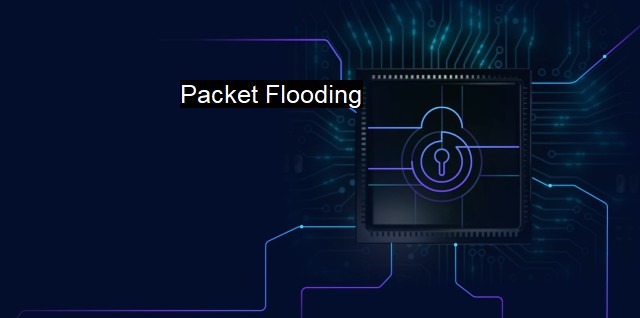What is Packet Flooding?
Packet Flooding: Understanding the Cyberattack and Methods of Defense against Defective Protocols and SYN Floods"
Packet flooding in the realm of cybersecurity and antivirus refers to a mode of malicious attack on a network where an overwhelming volume of data packets are sent to a targeted server or network system, congesting or blocking the system’s ability to process other requests. packet flooding operates the schematics of a 'Denial of Service (DoS)' or a 'Distributed Denial of Service (DDoS)' attack, suppressing the network and rendering it almost unserviceable. Sometimes, the primary intent could be to destroy a network or its service entirely.Data communication over the internet happens through packets, which are succinct units in which data is divided for efficient routing and transmission. Packet flooding, therefore, becomes a perilous threat when a malefactor decides to overburden a network system by sending high volumes of packets frequently. These packets, often laden with dummy data, characterize a bombarding effect by constantly demanding the system's attention and processing power, thereby stifling legitimate traffic and requests.
The serious implications of packet flooding can effectively incapacitate a system in various ways. Firstly, network performance invariably suffers as the inundated system bogs down at some point due to this data deluge. Online services begin to falter, servers struggle with their response times, and what's worse; the entire system may eventually plummet towards a valve-bouncing crash if the flooding perpetuates uncontrolled.
Secondly, the compromised networks' reputation and user trust levels suffer immensely. Ciphering and deciphering every packet for potential threats is a daunting, resource-intensive process. Following a flooding incident, panic is expected to shroud system operators and users alike, mainly if confidential data and critical services are involved.
Ready availability of easy-to-use software applications that can easily generate packet floods became a significant concern, artificial Intelligence, machine learning, and sophisticated virus algorithms not helping the mitigation efforts any better. Using these programs, even inexperienced attackers can plot and execute fatal flooding attacks efficiently. Explicit defenses against packet floods demand automated mechanisms in the cybersecurity arsenal like AI-based detection softwares and integrated mitigation techniques.
One of the more effective remediation techniques is the employment of interrupt moderation. Through this, the receiving system needs not process an interrupt for each incoming packet. Instead, it allows the confluence of several packets together, utilizing the system's hardware more efficiently and buys time to handle more traffic.
The implementation of a proper rate-limiting methodology also helps by simply putting a ceiling on the number of packets that can pass through a network. Here the recipient server controls the flow rate of incoming packets through policies so that any unusual surge automatically becomes noticeable, prompting immediate attention.
Traffic management, which permits or denies access on the basis of identities, is another valuable tool in mitigating the packet floods menace. Traffic filtering measures, routing policies, along with antivirus software and firewalls, are then conscribed under the comprehensive incident management planning. They act like gatekeepers, determining and substantiating the identity of both the sender and the information carried in the packet.
The rising avenue of threat detection employs machine learning approaches to anticipate and respond to value anomalies and potential malicious traffic patterns proactively. AI operates by streamlining vast logs of network activities into coherent narratives and actionable intelligence. This advantageously paves the way for near real-time access to network traffic patterns, fervently scouring the landscape for a potential attack.
While modern advances have been exceptional in countering packet attacks with their innovative methodologies, it still remains an uphill battle. End-to-end encryption, anonymity networks, and decentralized architectures pose significant challenges for threat detection and response tools. with constant upgrades in AI capabilities and evolving consensus tactics, the cybersecurity front stands undeterred in its efforts to stave off packet floods and other such cyber attacks.

Packet Flooding FAQs
What is packet flooding?
Packet flooding is a type of cyberattack that floods a network or system with an overwhelming amount of traffic, causing it to crash or become unavailable to users.How is packet flooding carried out?
Packet flooding is usually conducted by sending a large number of data packets to a target system or network from multiple sources at a very high rate. This overwhelms the system or network's capacity to process the incoming traffic, which causes it to crash or become unavailable.What are the impacts of packet flooding attacks?
The impact of packet flooding attacks can be severe, including denial of service (DoS), degradation of network performance, and even permanent damage. These attacks can also be used as a smokescreen to distract security teams while other attacks are carried out.How can organizations defend against packet flooding attacks?
Organizations can defend against packet flooding attacks by implementing robust network security measures, including firewalls, intrusion detection and prevention systems, and traffic filtering tools. They can also use bandwidth throttling and rate limiting to prevent excessive traffic from flooding their networks. Regular network vulnerability assessments and penetration testing can help identify and address potential weaknesses that may be exploited by attackers.| | A | | | B | | | C | | | D | | | E | | | F | | | G | | | H | | | I | | | J | | | K | | | L | | | M | |
| | N | | | O | | | P | | | Q | | | R | | | S | | | T | | | U | | | V | | | W | | | X | | | Y | | | Z | |
| | 1 | | | 2 | | | 3 | | | 4 | | | 7 | | | 8 | | |||||||